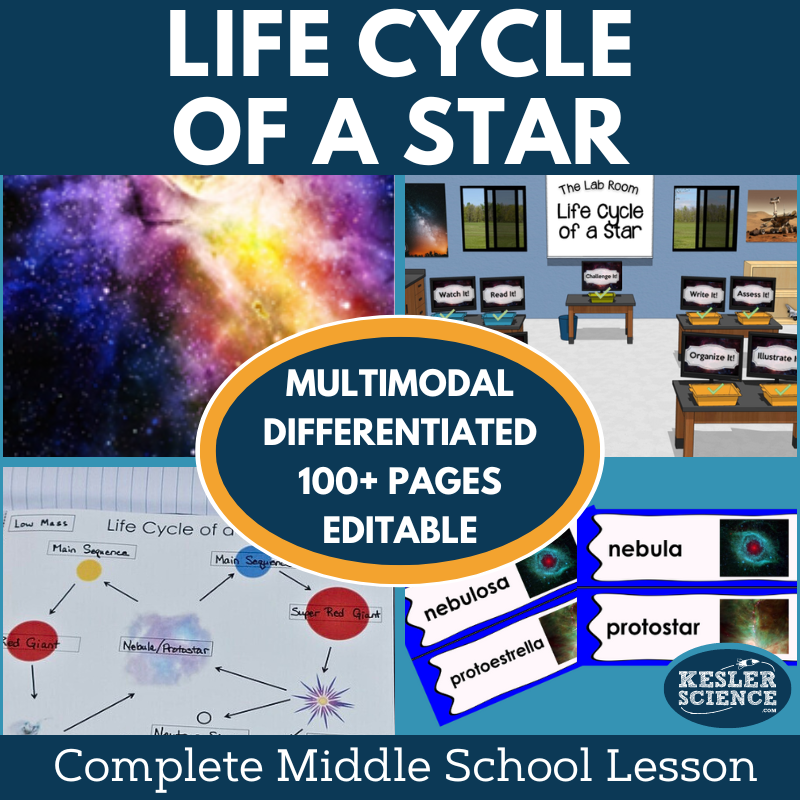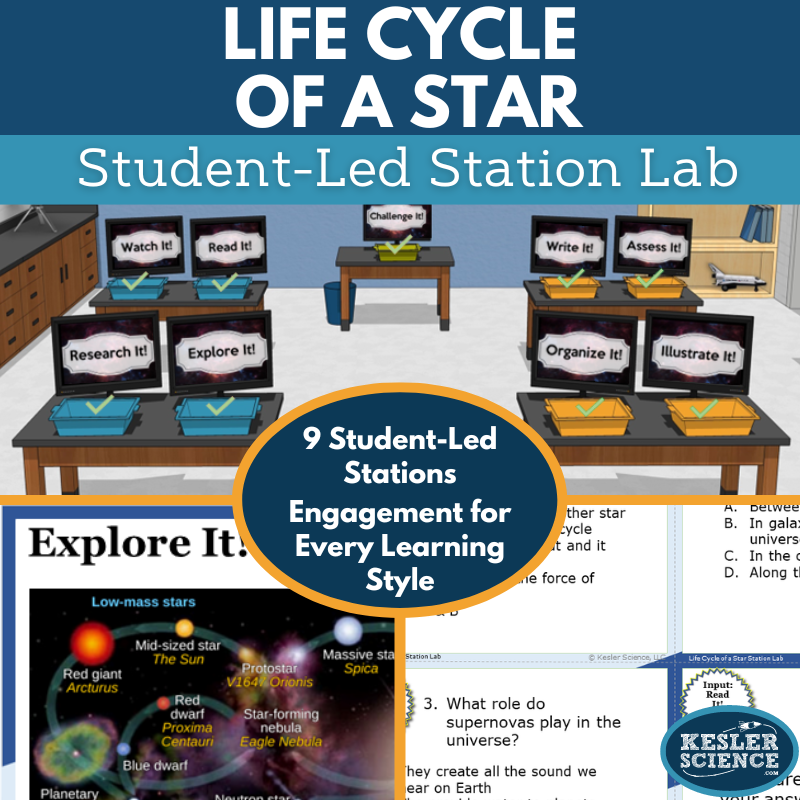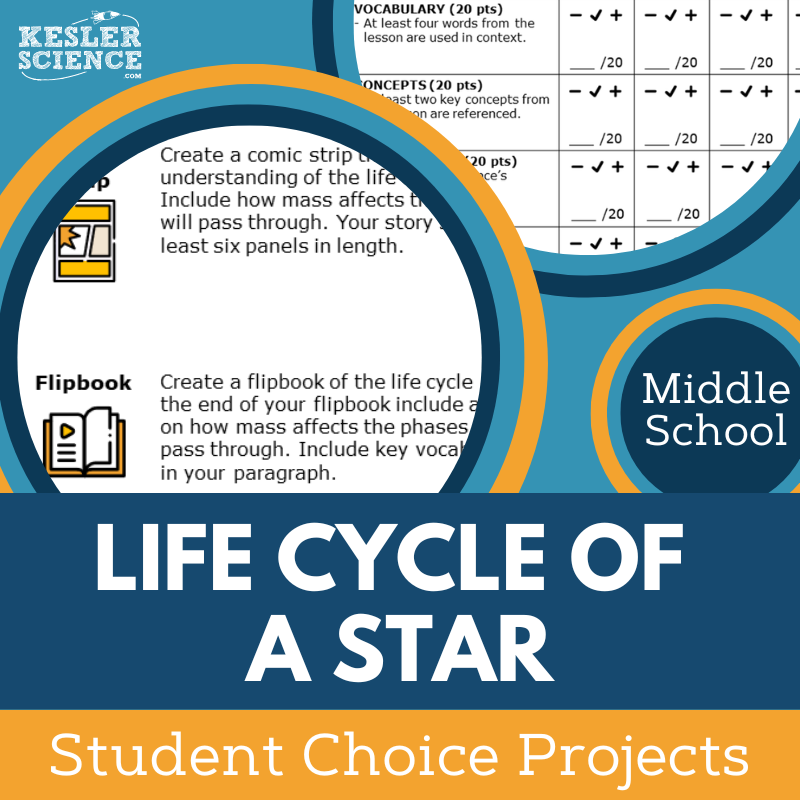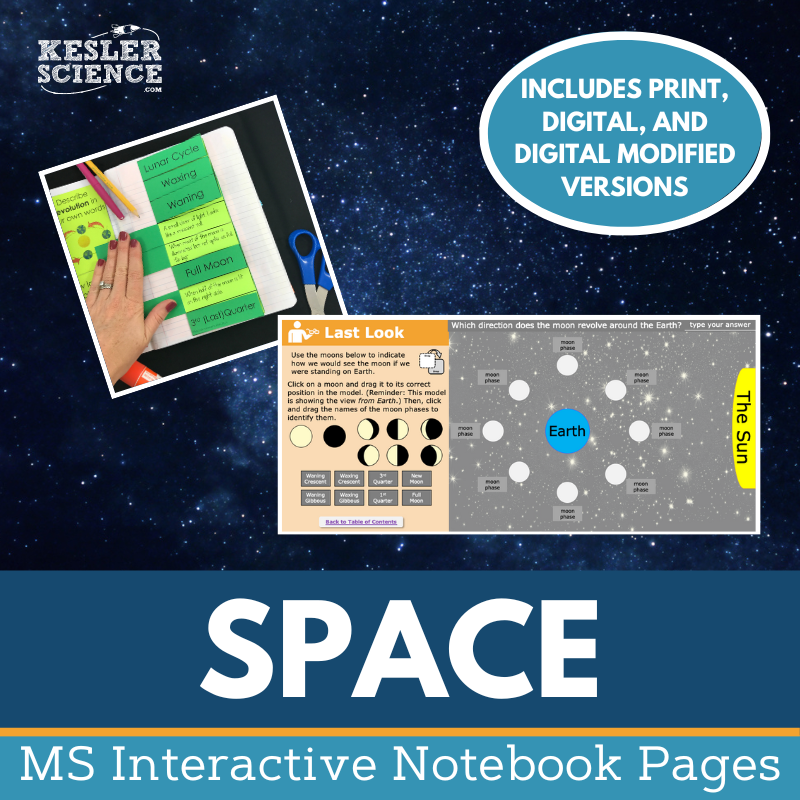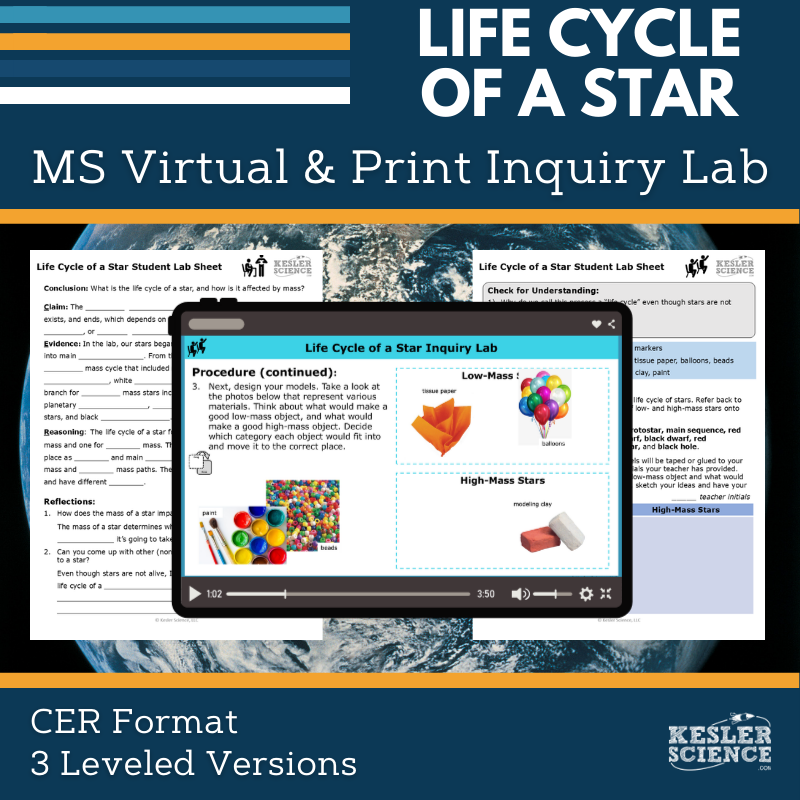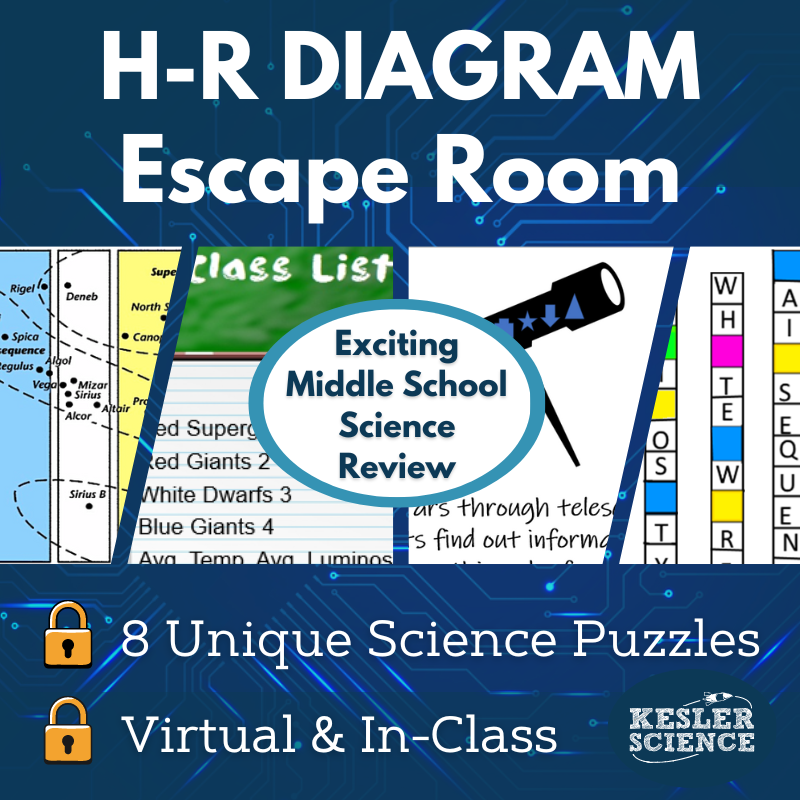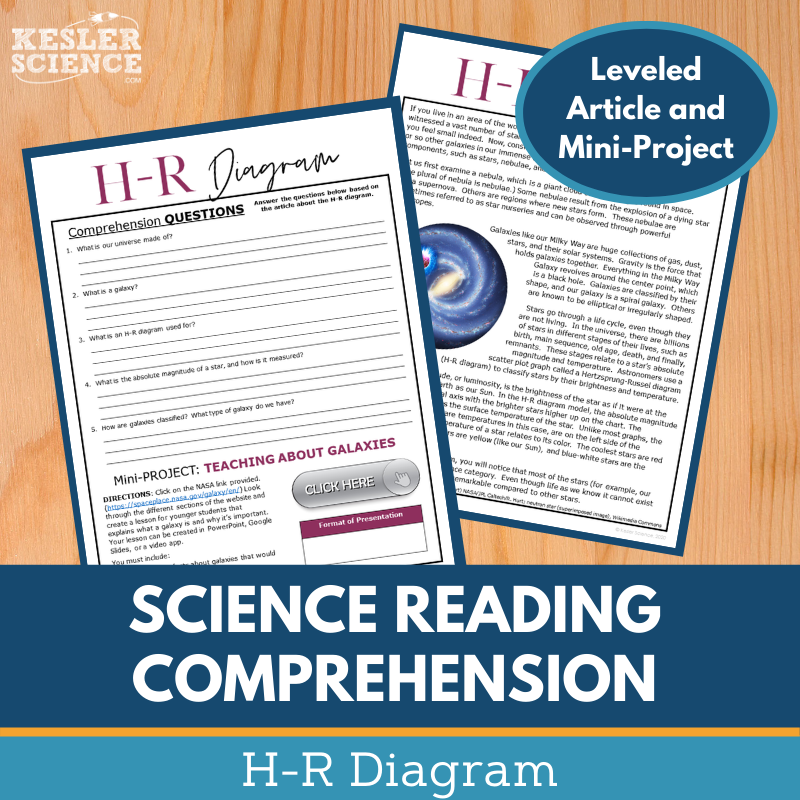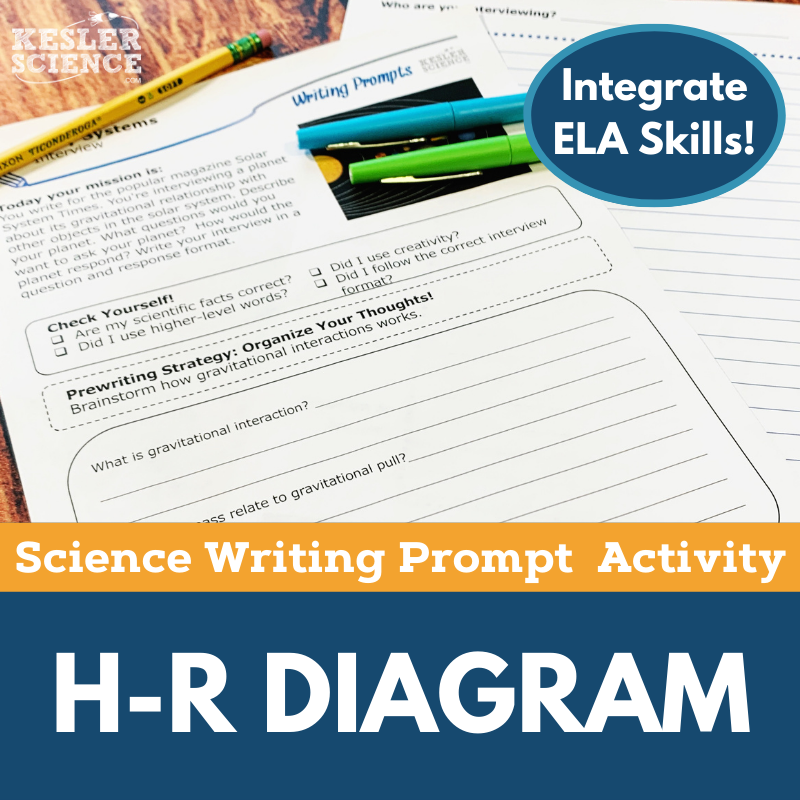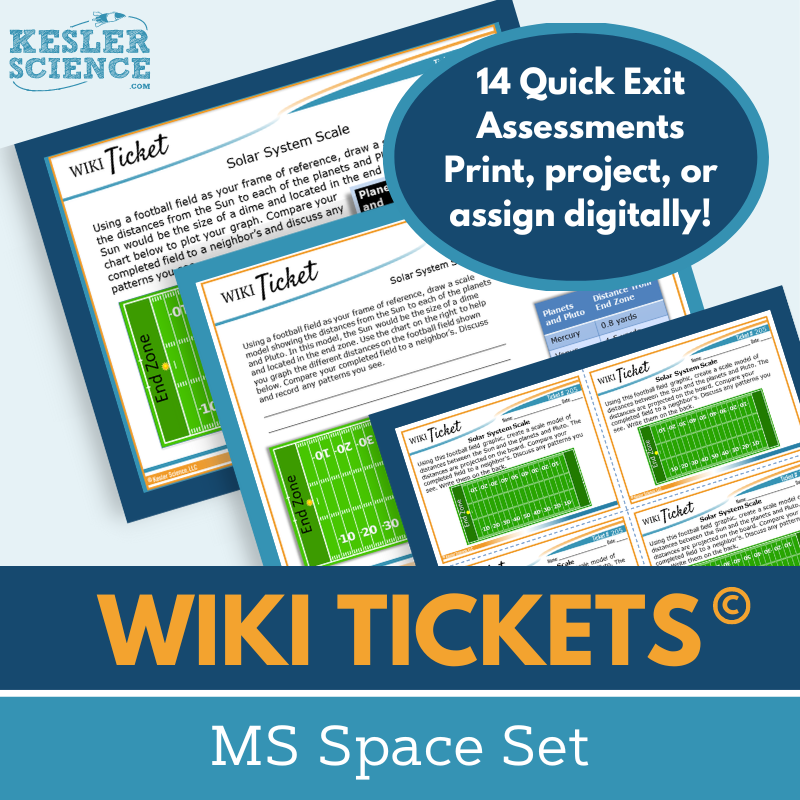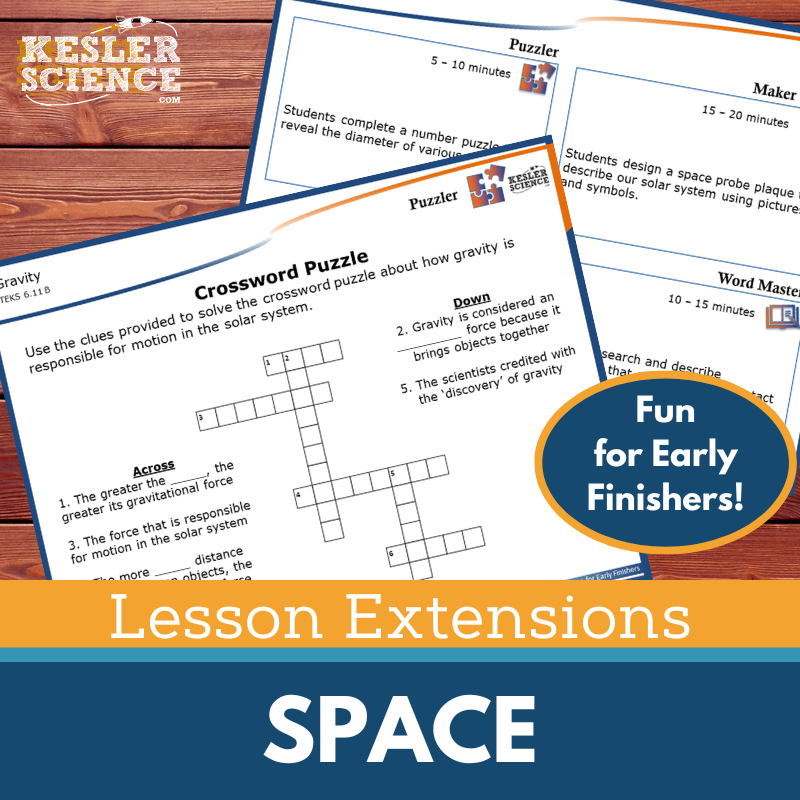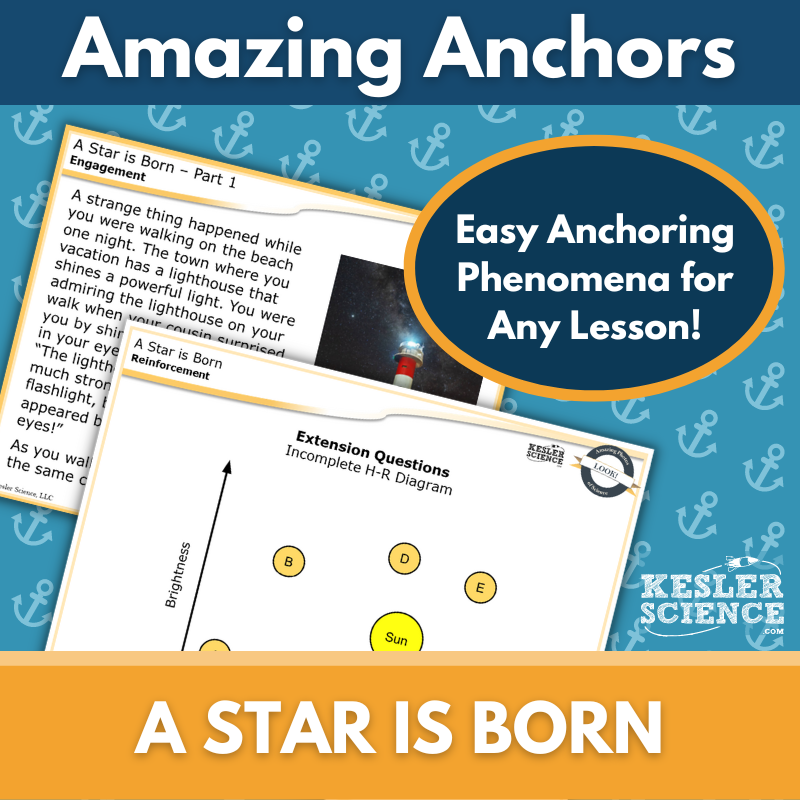Life Cycle of a Star Activities for Middle School Science
The Kesler Science Life Cycle of a Star resources provide engaging, student-centered activities to explore how a star's mass determines its life cycle. The resources below will give students a comprehensive understanding of the life cycle of a star. All of the following materials are also included in the Kesler Science Membership.
The Kesler Science Life Cycle of a Star 5E Lesson engages middle school students in exploring how a star’s mass determines its evolutionary sequence. This comprehensive unit includes presentations, worksheets, station labs, choice projects, and assessments—all fully editable and designed for minimal prep. With differentiated, student-led learning, the lesson caters to various abilities and frees up teacher time to focus on student success.
Following the 5E Model, the unit covers each phase of learning. The Engagement stage uses objectives, vocabulary cards, and discussion activities to spark curiosity. During Exploration, students participate in differentiated station labs with Input Stations (hands-on experiments, readings, videos) and Output Stations (organizing, writing, illustrating, and assessing). The Explanation phase includes editable PowerPoints, interactive notebook templates, and note-taking guides. Elaboration encourages deeper learning through student-choice projects, while Evaluation features differentiated assessments and review worksheets.
The Kesler Science Life Cycle of a Star 5E Lesson engages middle school students in exploring how a star’s mass determines its evolutionary sequence. This comprehensive unit includes presentations, worksheets, station labs, choice projects, and assessments—all fully editable and designed for minimal prep. With differentiated, student-led learning, the lesson caters to various abilities and frees up teacher time to focus on student success.
Following the 5E Model, the unit covers each phase of learning. The Engagement stage uses objectives, vocabulary cards, and discussion activities to spark curiosity. During Exploration, students participate in differentiated station labs with Input Stations (hands-on experiments, readings, videos) and Output Stations (organizing, writing, illustrating, and assessing). The Explanation phase includes editable PowerPoints, interactive notebook templates, and note-taking guides. Elaboration encourages deeper learning through student-choice projects, while Evaluation features differentiated assessments and review worksheets.
The Kesler Science Life Cycle of a Star Station Lab is a modular, student-led activity designed to engage middle school students in exploring key space science concepts. This comprehensive resource helps students learn about the Sun's position in the Milky Way and its proximity to Earth compared to other stars. With minimal prep, teachers can facilitate a student-centered experience that promotes independent and collaborative learning.
The lab features eight differentiated stations, plus a ninth challenge station for advanced learners or early finishers. Input stations—such as "Explore It!", "Research It!", "Read It!", and "Watch It!"—provide multimodal ways to introduce new concepts, while Output stations like "Organize It!", "Illustrate It!", "Write It!", and "Assess It!" allow students to demonstrate their understanding through creative and varied methods.
Complete with all signage, literature, and task cards, this resource is ideal for both in-person and virtual learning. Students can interact with hands-on materials or digital tools, fostering deeper understanding and retention of the life cycle of a star through engaging and personalized activities.
The Kesler Science Life Cycle of a Star Station Lab is a modular, student-led activity designed to engage middle school students in exploring key space science concepts. This comprehensive resource helps students learn about the Sun's position in the Milky Way and its proximity to Earth compared to other stars. With minimal prep, teachers can facilitate a student-centered experience that promotes independent and collaborative learning.
The lab features eight differentiated stations, plus a ninth challenge station for advanced learners or early finishers. Input stations—such as "Explore It!", "Research It!", "Read It!", and "Watch It!"—provide multimodal ways to introduce new concepts, while Output stations like "Organize It!", "Illustrate It!", "Write It!", and "Assess It!" allow students to demonstrate their understanding through creative and varied methods.
Complete with all signage, literature, and task cards, this resource is ideal for both in-person and virtual learning. Students can interact with hands-on materials or digital tools, fostering deeper understanding and retention of the life cycle of a star through engaging and personalized activities.
The Kesler Science Life Cycle of a Star Student Choice Projects empower middle school students to showcase their understanding in a way that aligns with their preferred output style. With six distinct project options, plus a "design your own" project, students engage in personalized, creative exploration. A flexible grading rubric supports assessments by teachers, peers, or students themselves, offering an adaptable approach to evaluation.
This resource includes nine project options and a modified version to support students needing remediation or differentiation, ensuring accessibility for all learners. Advanced students can be challenged with multiple project combinations, all assessed using the same rubric. Editable templates allow teachers to tailor the grading criteria to their specific classroom needs.
Requiring minimal supplies like paper, markers, and scissors, the projects are easy to implement and can also be completed digitally. With these multimodal activities, students gain a deeper understanding of the life cycle of a star while enjoying the freedom to explore and express their creativity.
The Kesler Science Life Cycle of a Star Student Choice Projects empower middle school students to showcase their understanding in a way that aligns with their preferred output style. With six distinct project options, plus a "design your own" project, students engage in personalized, creative exploration. A flexible grading rubric supports assessments by teachers, peers, or students themselves, offering an adaptable approach to evaluation.
This resource includes nine project options and a modified version to support students needing remediation or differentiation, ensuring accessibility for all learners. Advanced students can be challenged with multiple project combinations, all assessed using the same rubric. Editable templates allow teachers to tailor the grading criteria to their specific classroom needs.
Requiring minimal supplies like paper, markers, and scissors, the projects are easy to implement and can also be completed digitally. With these multimodal activities, students gain a deeper understanding of the life cycle of a star while enjoying the freedom to explore and express their creativity.
The Kesler Science Space Science Interactive Notebook is an engaging resource for teachers looking to create interactive learning experiences for their students. It includes both print and digital versions, making it perfect for traditional classrooms, 1:1 environments, or distance learning.
The bundle covers key space science topics such as asteroids, meteors, and comets, the Big Bang theory, eclipses, the electromagnetic spectrum, galaxies, and more. The digital version features a PowerPoint interactive notebook, which can be uploaded to Google Slides or learning management systems like MS Teams or Canvas. Reflection pages and space for students to take notes are included, along with a teacher answer key and modified versions for students with accommodations.
The print version provides a full set of blank templates for students, pre-filled templates for those needing modifications, and color photos to illustrate how each template should be used. This bundle is designed to support differentiated learning and keep students engaged in key space science concepts.
The Kesler Science Space Science Interactive Notebook is an engaging resource for teachers looking to create interactive learning experiences for their students. It includes both print and digital versions, making it perfect for traditional classrooms, 1:1 environments, or distance learning.
The bundle covers key space science topics such as asteroids, meteors, and comets, the Big Bang theory, eclipses, the electromagnetic spectrum, galaxies, and more. The digital version features a PowerPoint interactive notebook, which can be uploaded to Google Slides or learning management systems like MS Teams or Canvas. Reflection pages and space for students to take notes are included, along with a teacher answer key and modified versions for students with accommodations.
The print version provides a full set of blank templates for students, pre-filled templates for those needing modifications, and color photos to illustrate how each template should be used. This bundle is designed to support differentiated learning and keep students engaged in key space science concepts.
The Life Cycle of a Star Inquiry Lab helps students explore the life cycle of stars by comparing and contrasting the paths of low- and high-mass stars. Designed to align with the NGSS, this resource includes hands-on and digital formats that engage students in modeling, reflection, and Claim-Evidence-Reasoning (C.E.R.) writing. Students use materials like tissue paper, balloons, and clay for the print version, while the digital version offers fully interactive activities without the need for supplies.
This lab features three differentiated levels—dependent, modified, and independent—providing built-in support for a range of learners. The dependent version guides students with inquiry-based prompts, the modified version offers additional structure and support such as sentence stems, and the independent version encourages student-led exploration with minimal guidance. Each version includes comprehension questions and a reflection section to reinforce learning.
Editable files in both print and digital formats make it easy to tailor the lab to your classroom’s needs. The resource includes teacher pages with directions, prep time, objectives, and answer keys. Compatible with Google Slides, MS Teams, Schoology, and Canvas, the Life Cycle of a Star Inquiry Lab offers a flexible, engaging way to explore how mass influences a star’s evolution.
The Life Cycle of a Star Inquiry Lab helps students explore the life cycle of stars by comparing and contrasting the paths of low- and high-mass stars. Designed to align with the NGSS, this resource includes hands-on and digital formats that engage students in modeling, reflection, and Claim-Evidence-Reasoning (C.E.R.) writing. Students use materials like tissue paper, balloons, and clay for the print version, while the digital version offers fully interactive activities without the need for supplies.
This lab features three differentiated levels—dependent, modified, and independent—providing built-in support for a range of learners. The dependent version guides students with inquiry-based prompts, the modified version offers additional structure and support such as sentence stems, and the independent version encourages student-led exploration with minimal guidance. Each version includes comprehension questions and a reflection section to reinforce learning.
Editable files in both print and digital formats make it easy to tailor the lab to your classroom’s needs. The resource includes teacher pages with directions, prep time, objectives, and answer keys. Compatible with Google Slides, MS Teams, Schoology, and Canvas, the Life Cycle of a Star Inquiry Lab offers a flexible, engaging way to explore how mass influences a star’s evolution.
The Kesler Science H-R Diagram Escape Room offers an immersive and interactive way for middle school students to demonstrate their understanding of the Hertzsprung-Russell diagram. Teachers can select from eight independent puzzles, allowing for flexibility in puzzle selection and the order in which they are used, making it suitable for both short and long class periods.
Materials are provided for two different versions of the escape room. The simplest method involves using manila envelopes and printed materials, while a more authentic setup requires locks and a storage box. For digital use, the single student digital version allows students to solve puzzles through Google Slides or PowerPoint, providing a flexible option for remote learning.
Included in the product are teacher directions, a detailed answer key, and a variety of resources such as video challenges, reward templates, and signs for a fun photo opportunity. The escape room is also compatible with Google Classroom for a seamless online experience, ensuring that students are engaged both in-person and virtually.
Materials are provided for two different versions of the escape room. The simplest method involves using manila envelopes and printed materials, while a more authentic setup requires locks and a storage box. For digital use, the single student digital version allows students to solve puzzles through Google Slides or PowerPoint, providing a flexible option for remote learning.
Included in the product are teacher directions, a detailed answer key, and a variety of resources such as video challenges, reward templates, and signs for a fun photo opportunity. The escape room is also compatible with Google Classroom for a seamless online experience, ensuring that students are engaged both in-person and virtually.
In the Kesler Science H-R Diagram reading comprehension activity, students explore the Hertzsprung-Russell Diagram by reading a nonfiction article about how components of the universe are classified. They then answer comprehension questions and complete a mini-project, creating a presentation about galaxies. This lesson is designed to enhance reading comprehension while deepening understanding of scientific concepts.
The science reading passage is leveled for middle school students (grades 6-8), with Lexile levels ranging from 1100-1300. Two versions of the article are included to accommodate different reading abilities. Each passage is paired with 5-7 comprehension questions and a hands-on mini-project, providing a well-rounded learning experience. A Cornell notes template is also included to support student note-taking.
This resource is perfect for both in-person and virtual learning environments, with files compatible with Google Classroom, MS Teams, and other platforms. It offers flexibility for various teaching scenarios, including assignments for absent students, extra credit, or whole-class instruction. The articles foster classroom discussions and help students build science literacy and critical reading skills.
In the Kesler Science H-R Diagram reading comprehension activity, students explore the Hertzsprung-Russell Diagram by reading a nonfiction article about how components of the universe are classified. They then answer comprehension questions and complete a mini-project, creating a presentation about galaxies. This lesson is designed to enhance reading comprehension while deepening understanding of scientific concepts.
The science reading passage is leveled for middle school students (grades 6-8), with Lexile levels ranging from 1100-1300. Two versions of the article are included to accommodate different reading abilities. Each passage is paired with 5-7 comprehension questions and a hands-on mini-project, providing a well-rounded learning experience. A Cornell notes template is also included to support student note-taking.
This resource is perfect for both in-person and virtual learning environments, with files compatible with Google Classroom, MS Teams, and other platforms. It offers flexibility for various teaching scenarios, including assignments for absent students, extra credit, or whole-class instruction. The articles foster classroom discussions and help students build science literacy and critical reading skills.
The Kesler Science H-R Diagram Science Writing Prompt Activity engages middle school students in a creative, low-prep activity centered around the H-R Diagram. Students use poetry to explore scientific concepts, testing their knowledge while developing their writing skills. This student-centered activity is perfect for elaboration, review, or differentiation, and it can be used in conjunction with other Kesler Science resources.
Included in the purchase are teacher directions, answer guides, rubrics, and a variety of handouts, both in full-size and half-sheet formats. The materials are designed for easy classroom or virtual learning, with a digital interactive version available for use in Google Slides or PowerPoint.
This activity is versatile, making it suitable for multiple uses such as cross-curricular exercises, formative assessments, student choice projects, and extra credit. It's also ideal for differentiation, early finishers, or make-up work, allowing students to stay engaged whether in-person or remotely.
The Kesler Science H-R Diagram Science Writing Prompt Activity engages middle school students in a creative, low-prep activity centered around the H-R Diagram. Students use poetry to explore scientific concepts, testing their knowledge while developing their writing skills. This student-centered activity is perfect for elaboration, review, or differentiation, and it can be used in conjunction with other Kesler Science resources.
Included in the purchase are teacher directions, answer guides, rubrics, and a variety of handouts, both in full-size and half-sheet formats. The materials are designed for easy classroom or virtual learning, with a digital interactive version available for use in Google Slides or PowerPoint.
This activity is versatile, making it suitable for multiple uses such as cross-curricular exercises, formative assessments, student choice projects, and extra credit. It's also ideal for differentiation, early finishers, or make-up work, allowing students to stay engaged whether in-person or remotely.
The Kesler Science Space WIKI Tickets are engaging formative assessments designed for 6th-8th grade science topics, offering multiple flexible formats to check student understanding. Each topic in the Space Set includes five versions: full-screen display, three handout sizes (full, split, and quarter-page), and a digital interactive option that can be used as an editable PowerPoint or Google Slides file.
These assessments are aligned with NGSS and TEKS middle school science standards, with some topics featuring multiple tickets. Each set also includes a bonus table of contents file to show standard alignment, ensuring a comprehensive understanding of the covered topics.
Perfect for both in-class and remote learning, WIKI Tickets can be used as exit tickets, bellringers, or anytime you need to gauge students' progress. Whether projected on a screen or completed digitally, these colorful and engaging assessments provide valuable insight into student comprehension of key space science topics such as the lunar cycle, solar system properties, and space exploration.
The Kesler Science Space WIKI Tickets are engaging formative assessments designed for 6th-8th grade science topics, offering multiple flexible formats to check student understanding. Each topic in the Space Set includes five versions: full-screen display, three handout sizes (full, split, and quarter-page), and a digital interactive option that can be used as an editable PowerPoint or Google Slides file.
These assessments are aligned with NGSS and TEKS middle school science standards, with some topics featuring multiple tickets. Each set also includes a bonus table of contents file to show standard alignment, ensuring a comprehensive understanding of the covered topics.
Perfect for both in-class and remote learning, WIKI Tickets can be used as exit tickets, bellringers, or anytime you need to gauge students' progress. Whether projected on a screen or completed digitally, these colorful and engaging assessments provide valuable insight into student comprehension of key space science topics such as the lunar cycle, solar system properties, and space exploration.
The Kesler Science Space Lesson Extensions provide engaging activities designed to challenge fast finishers and deepen student learning. These critical thinking tasks are connected to NGSS and TEKS space standards, offering rigorous but fun opportunities to explore topics in greater depth. With activities like puzzles, hands-on maker space tasks, tech connections, and creative word writing, these extensions promote STEAM skills and digital literacy.
The Lesson Extensions are structured to provide flexible support for teachers, with clear directions, answer keys, and both digital and paper versions. These materials help reinforce the lesson’s core concepts while offering ways to engage students during testing or other gaps in the schedule.
Perfect for independent learners, these activities push students to apply their knowledge creatively while connecting it to real-world applications. The extensions cover a variety of space science topics, including gravity, space travel, and the lunar cycle, providing additional challenges that extend the learning experience beyond the standard lesson.
The Kesler Science Space Lesson Extensions provide engaging activities designed to challenge fast finishers and deepen student learning. These critical thinking tasks are connected to NGSS and TEKS space standards, offering rigorous but fun opportunities to explore topics in greater depth. With activities like puzzles, hands-on maker space tasks, tech connections, and creative word writing, these extensions promote STEAM skills and digital literacy.
The Lesson Extensions are structured to provide flexible support for teachers, with clear directions, answer keys, and both digital and paper versions. These materials help reinforce the lesson’s core concepts while offering ways to engage students during testing or other gaps in the schedule.
Perfect for independent learners, these activities push students to apply their knowledge creatively while connecting it to real-world applications. The extensions cover a variety of space science topics, including gravity, space travel, and the lunar cycle, providing additional challenges that extend the learning experience beyond the standard lesson.
This Amazing Anchors Phenomenon Lesson introduces and reinforces the H-R Diagram through real-world connections. It begins with an introductory reading focused on the brightness of stars, followed by comprehension and extension questions that activate prior knowledge. An explanatory reading then breaks down the science behind H-R Diagrams, helping students build a deeper understanding with additional reinforcement questions.
The no-prep resource is TEKS-aligned and includes teacher directions, answer keys, and projection slides. It’s available in multiple formats: full-page projection slides, editable PowerPoints for digital use, and printable half- and full-sheet handouts for interactive notebooks. A differentiated version with sentence starters is included to support student comprehension.
Designed to supplement a full lesson, this two-part activity works well as an engagement tool and follow-up task within the 5E Model. Its flexibility allows for seamless integration in both in-person and virtual learning environments, making it an ideal way to anchor instruction around the H-R Diagram.
This Amazing Anchors Phenomenon Lesson introduces and reinforces the H-R Diagram through real-world connections. It begins with an introductory reading focused on the brightness of stars, followed by comprehension and extension questions that activate prior knowledge. An explanatory reading then breaks down the science behind H-R Diagrams, helping students build a deeper understanding with additional reinforcement questions.
The no-prep resource is TEKS-aligned and includes teacher directions, answer keys, and projection slides. It’s available in multiple formats: full-page projection slides, editable PowerPoints for digital use, and printable half- and full-sheet handouts for interactive notebooks. A differentiated version with sentence starters is included to support student comprehension.
Designed to supplement a full lesson, this two-part activity works well as an engagement tool and follow-up task within the 5E Model. Its flexibility allows for seamless integration in both in-person and virtual learning environments, making it an ideal way to anchor instruction around the H-R Diagram.
Year-Round Resources
These year-round activities will increase your students' understanding of many middle school science topics. All of these activities are also included in the Kesler Science Membership.
Visual Data & Graphing
You're not alone if your students struggle with understanding graphs, charts, and tables. It's a skill that takes an enormous amount of practice. This resource will help students build a strong foundation in analyzing data and creating their own data visualizations.
Bell Ringers and Warm-Ups
These middle school science bell ringers are an excellent way to engage your students as soon as they walk into your classroom. This comprehensive FULL YEAR resource includes everything you need to start off each science class with an interesting warm-up activity.
Review Board Games
Each game board has been carefully designed to keep students engaged. There are 10 different action spaces on each board and dozens of question cards. All of the actions are related to science concepts and keep the students motivated throughout the game.
Each game is ready to play. Simply print out the board and the cards and let the students enjoy reviewing nine different units.
Essential Questions
Below are the essential questions associated with the lessons and activities included in this unit. This topic is only one of more than 100 middle school science topics included in the Kesler Science Membership.
-
What is the life cycle of a star?
-
How does the mass of a star predict the sequence of events in the life cycle of that star?
Kesler Science Membership
Imagine never having to search for another middle school science lesson again. The membership gives you access to ALL of the Kesler Science products in one place (Yes, including everything above).
Say goodbye to long hours of lesson prep.

